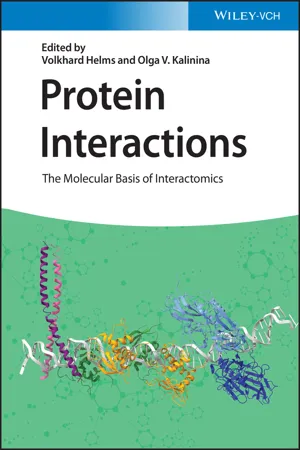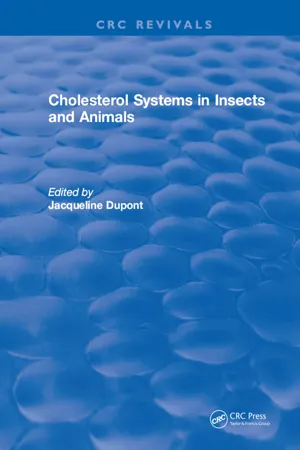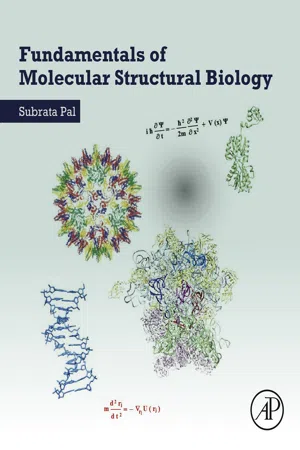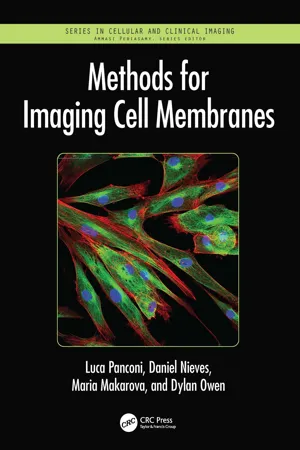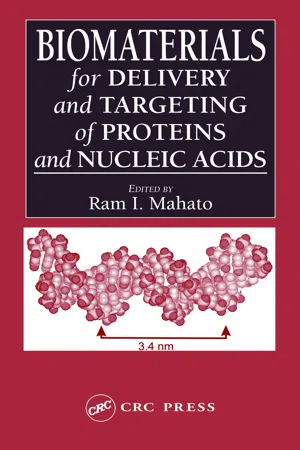Biological Sciences
Plasma Membrane
The plasma membrane is a vital component of all cells, serving as a barrier that separates the cell's interior from its external environment. Composed of a double layer of phospholipid molecules embedded with proteins, the plasma membrane regulates the passage of substances in and out of the cell, enabling it to maintain its internal environment and interact with its surroundings.
Written by Perlego with AI-assistance
Related key terms
Related key terms
1 of 4
Related key terms
1 of 3
12 Key excerpts on "Plasma Membrane"
- eBook - ePub
Drug-Biomembrane Interaction Studies
The Application of Calorimetric Techniques
- Rosario Pignatello(Author)
- 2013(Publication Date)
- Woodhead Publishing(Publisher)
All living cells, prokaryotic and eukaryotic, possess a thin cell or Plasma Membrane (also known as plasmalemma), which encloses their contents and acts as a semi-porous barrier to the outside environment. It also serves as the communications interface between the cell and its environment. Biological membranes also compartmentalize cellular organelles and their functions. Inside a cell, the endoplasmic reticulum, Golgi apparatus, lysosomes, vesicles and vacuoles are surrounded by a single biomembrane sheet. Mitochondria and the nucleus are surrounded by two membrane layers. Finally, the membrane regulates the flow of materials into and out of the cell, mediates intercellular communication, contacts and adhesion, and performs a multitude of other tasks.Various scientific hypotheses have been used to describe the structure of Plasma Membranes and Eichman wrote a good historical description.9 Of the various models, the most accepted theory is the fluid mosaic model, which was developed by Singer and Nicolson in 1972. According to this theory, a cell membrane consists of a continuous, fluid, double layer of phospholipid (PL), containing or attaching to in different ways other components like proteins, carbohydrates and cholesterol (CHOL) (see below). In a very simplified visualization, the PLs form a thin, flexible sheet, while the proteins float in this sheet like icebergs, and the carbohydrates protrude out from the surface (Figure 1.1 ).Figure 1.1 The fluid mosaic model of cell membranesThe name of this model arises from the assumption that the Plasma Membrane is not rigid, but exists in a fluid state where the different molecules are arranged like a mosaic pattern. The arrangement of these molecules is, however, not random, but regulated (in the physiological state) or dysregulated (in a disease state), which affects the coexistence, movement, trafficking and function of each component and of the entire membrane. Alterations to cell membrane dynamics and strength are often associated with disease. - eBook - ePub
Protein Interactions
The Molecular Basis of Interactomics
- Volkhard Helms, Olga V. Kalinina(Authors)
- 2022(Publication Date)
- Wiley-VCH(Publisher)
13 Interaction Between Proteins and Biological Membranes Lorant Janosi1 and Alemayehu A. Gorfe2,3 1 National Institute for Research and Development of Isotopic and Molecular Technologies, Department of Molecular and Biomolecular Physics, 67‐103 Donat Street, PO 5 Box 700, Cluj‐Napoca, CJ, 400293, Romania 2 University of Texas Health Science Center, Department of Integrative Biology & Pharmacology, McGovern Medical School, 6431 Fannin St, Houston, TX, 77030, USA 3 MD Anderson Cancer Center UTHealth Graduate School of Biomedical Sciences, 6431 Fannin St, Houston, TX, 77030, USA13.1 Introduction
The survival of every cell is dependent upon the maintenance of membrane homeostasis, an actively controlled process of regulating membrane composition, structure, and dynamics. The cell membrane is the boundary that separates a cell from its surroundings and shields the contents of internal organelles. Specifically, the Plasma Membrane is a semipermeable protective envelope of cells and plays critical role in the regulated movement of material between the interior of the cell and its surroundings. Similarly, internal or endomembranes compartmentalize intracellular cell components into various organelles, such as the Golgi apparatus, endoplasmic reticulum, and the nucleus. Membranes also serve as vesicles to transport cargo across the cytosol, as well as into and out of the cell, as two‐dimensional structural frameworks to host and organize proteins involved in substrate transport, signaling, and other functions. The focus of this chapter is on the fundamental interactions responsible for the targeting and stability of these proteins in membranes.The topic of the interactions of proteins with biological membranes is too broad to cover in full in a single chapter. Therefore, we will focus on two major classes of proteins, peripheral and integral membrane proteins, and describe in general terms the most common mechanisms of targeting, stabilizing, and reorganizing these proteins inside or on the surface of membranes. Moreover, most of our discussion will focus on the Plasma Membrane, with only occasional references to endomembranes. This is because, while the Plasma Membrane and endomembranes differ in lipid composition and protein content, the fundamental interactions relevant to the structural integrity and function of membranes and membrane proteins are conserved. - No longer available |Learn more
MCAT Biochemistry Review 2024-2025
Online + Book
- (Author)
- 2023(Publication Date)
- Kaplan Test Prep(Publisher)
CHAPTER 8BIOLOGICAL MEMBRANES
In This Chapter
8.1 Fluid Mosaic Model General Membrane Structure and Function Membrane Dynamics8.2 Membrane ComponentsLipids Proteins Carbohydrates Membrane Receptors Cell–Cell Junctions8.3 Membrane TransportConcentration Gradients Passive Transport Active Transport Endocytosis and Exocytosis 8.4 Specialized Membranes Membrane Potential Mitochondrial MembranesConcept SummaryCHAPTER PROFILE
The content in this chapter should be relevant to about 10% of all questions about biochemistry on the MCAT. This chapter covers material from the following AAMC content categories:2A: Assemblies of molecules, cells, and groups of cells within single cellular and multicellular organisms3A: Structure and functions of the nervous and endocrine systems, and ways in which these systems coordinate the organ systemsIntroduction
Biological membranes are a stunning combination of opposites and contrasts. They are exceptionally thin, structurally bland, and relatively straightforward to describe. Yet, they define the borders of cells, tissues, and organelles; carry out a significant number of the biological functions within cells; and are an unending source of scientific inquiry and discovery. The most commonly tested biological membrane on the MCAT is the Plasma Membrane. At first, the Plasma Membrane seems like it’s only a shell—just a barrier that defines the cell. But the Plasma Membrane plays roles in signaling, entry of nutrients and expulsion of waste, cell recognition, transport of materials between tissues, and even electronic functions.Cell membranes have both a stretchy, flexible component (phospholipids) and an abundance of stabilizing molecules (cholesterol and protein) to make sure that everything remains intact. In this chapter, we will examine the general function, composition, and transport properties of biological membranes. We will conclude by taking a look at a few specialized cell membranes within the body, in addition to specific membrane properties. - eBook - ePub
- Jacqueline Dupont(Author)
- 2018(Publication Date)
- CRC Press(Publisher)
MEMBRANE FUNCTIONS Biological membranes are the structures that surround all living cells and most subcellular units, such as mitochondria, endoplasmic reticulum, golgi apparatus, nuclei, and lysosomes. They function to maintain the compositional differences between two aqueous compartments such as the inside and outside of a cell, or to permit change in a controlled manner. They were previously thought to be inert packaging materials, but are now known to fulfill a multitude of functions and to have a rather complicated structure. Membranes serve as screens to permit entry to and exit from the cell or compartment of nutrients and metabolic products where the screen can be either a passive barrier or an active transport system; they are the origins and carriers of electrical impulses in excitable membranes such as nerve axons; they function as energy transducers in membranes of photosynthetic organisms and visual systems; and they carry structures responsible for the recognition of substances regulating cell metabolism such as hormones and plasma lipoproteins as well as for cell-cell recognition that are essential for morphogenesis, immune responses, and carcinogenesis. Considering this variety of functions, composition and structure of membranes of different origins are remarkably similar. III. MEMBRANE COMPOSITION Lipids and proteins are quantitatively the major components but their relative amounts differ in different membrane systems (Table 1). The more metabolically active the system, the higher is the protein to lipid ratio. For instance, the major component of myelin that functions primarily as electrical insulator is lipid. Most cell membranes of animals serving predominantly transport functions contain approximately equal amounts of proteins and lipids. Plasma Membranes of bacterial cells and of inner membranes of mitochondria that are associated with oxidative phosphorylation and synthesis of nucleic acids contain up to two thirds of their mass as protein - eBook - ePub
The Physics of Living Processes
A Mesoscopic Approach
- Thomas Andrew Waigh(Author)
- 2014(Publication Date)
- Wiley(Publisher)
12 MembranesEvery living cell is surrounded by an outer membrane. The membrane acts as a dividing partition between the cell’s interior and exterior environments. It is the interface through which a cell communicates with the external world. Biological membranes are involved in a wide range of cellular activities. Simple mechanical functions occur using the membrane such as motility, food entrapment and transport. Also, highly specific biochemical processes are made possible by the membrane’s structure, which include energy transduction, nerve conduction and biosynthesis (Figure 12.1). Adhesion between cellular membranes is thought to be a critical factor for the determination of the morphology and the development of organisms (morphogenesis) from the initial ball of dividing cells (the blastula, Section 22.9 ).Schematic diagrams of (a) an animal and (b) a plant cell that show the compartmentalised structures and some individual pieces of intracellular machinery in two different types of eukaryotic cell.Figure 12.1[Copyright 2008 from Molecular Biology of the Cell, Fifth Edition by Alberts et al. Reproduced by permission of Garland Science/Taylor & Francis LLC.]Biological lipids in solution self-assemble into thin bilayer membranes that can compartmentalise different regions within a cell and protect the inside of the cell from the external environment. The membrane remains intact even when the bathing medium is extremely depleted of lipids due to the lipids’ extremely low critical micelle concentration (Section 8.1 ). Also, due to unsaturation and branching of the constituent lipids, the membranes are in a fluid state at physiological temperature, with rapid two-dimensional rearrangements possible of the neighbouring lipid molecules.Long-chained polypeptides are often embedded in membranes and consist of long strings of amino acid residues (~500 000). The polypeptides are rigid compared with the lipids in the surrounding cell membrane and they are amphiphilic, with their surface exposed to both hydrophobic and hydrophilic regions. These membrane proteins induce stress in the surrounding lipids, change the membrane’s curvature, and determine a range of functions that include adhesion and signalling. - eBook - ePub
Medicinal Chemistry
An Introduction
- Gareth Thomas(Author)
- 2011(Publication Date)
- Wiley(Publisher)
7 Biological membranes 7.1 IntroductionAll cells have a membrane, known as the cytoplasmic or Plasma Membrane , that separates the internal medium of a cell (intracellular fluid ) from its surrounding medium (extracellular fluid ). In the cells (eukaryotes ) of higher organisms, membranes also form the boundaries of the internal regions that retain the intracellular fluids in separate compartments (Figs. 7.1a and 7.1b ). Those compartments that can be recognised as separate entities, such as the nucleus, mitochondria and lysosomes, are known collectively as organelles . Organelles carry out specialised tasks within the cell. However, in the prokaryotic cells (Fig. 7.1c ) of simpler organisms where there are no organelles the Plasma Membrane is also involved in many of the functions of the organelles. The more fragile Plasma Membranes of plant cells and bacteria are also protected by a more rigid exterior covering known as the cell wall.The primary function of the Plasma Membrane is to maintain the integrity of the cell in its environment. It is now also known that the membranes of all types of cell regulate the transfer of substances in and out of the cell and between its internal compartments. This movement controls the health, as well as the flow of information between and within cells. The Plasma Membrane of a cell is also involved in both the generation and receipt of chemical and electrical signals, cell adhesion, which is responsible for tissue formation, cell locomotion, biochemical reactions and cell reproduction. The internal cell membranes have similar functions and, in addition, are often actively involved in the function of organelles. Most drugs either interact with the receptors and enzymes attached to the membrane or have to pass through a membrane in order to reach their site of action.The role of membranes and cell walls in maintaining cell integrity and their involvement in cellular function makes these areas of cells potential targets for drug action. However, in - eBook - ePub
- Britannica Educational Publishing, Kara Rogers(Authors)
- 2010(Publication Date)
- Britannica Educational Publishing(Publisher)
CHAPTER 2Cell Membranes and Cell WallsT he contents of all cells are enveloped by a highly specialized cell membrane. This membrane is a chemically complex structure and consists of multiple components, each of which contributes to the unique functions performed by the membrane. One of the most important of these functions is to serve as a protective layer, defending the cell interior against physical insult. In plants, a rigid cell wall reinforces this function, endowing stems, leaves, and roots with exceptional strength in the face of physical challenges ranging from wind to rain to sunlight.Contrasted against this physical role is the intricate regulatory nature of the membrane, which influences a variety of cellular activities, including the uptake of nutrients, cell-to-cell adhesion, and cell communication. Membrane-based regulatory capacity is made possible by the presence of diverse arrays of receptors and channels that recognize specific types of molecules, allowing them to enter and leave cells only under certain conditions, which are dictated by both intracellular and extracellular factors. This regulatory ability is one of the most complex and amazing features of cell membranes.THE CELL MEMBRANE
A thin membrane surrounds every living cell, delimiting the cell from the environment around it. Enclosed by this cell membrane (also known as the Plasma Membrane) are the cell’s constituents, often large, water-soluble, highly charged molecules such as proteins, nucleic acids, carbohydrates, and substances involved in cellular metabolism. Outside the cell, in the surrounding water-based environment, are ions, acids, and alkalis that are toxic to the cell, as well as nutrients that the cell must absorb in order to live and grow. The cell membrane, therefore, has two functions: first, to be a barrier keeping the constituents of the cell in and unwanted substances out and, second, to be a gate allowing transport into the cell of essential nutrients and movement from the cell of waste products. - eBook - ePub
- Subrata Pal(Author)
- 2019(Publication Date)
- Academic Press(Publisher)
Chapter 14Membrane structure and function
Abstract
Biomembranes consist of a hydrophobic matrix formed by a lipid bilayer with surface-bound and embedded proteins. The bilayer is both diverse and asymmetric in respect to its lipid composition. However, the amphipathic nature of all kinds of lipid molecules present in the membrane thermodynamically favors the formation of the common bilayer structure. Both lipids and proteins in the bilayer are in constant motion. As the boundary of a cell, the membrane displays a property of selective permeability, allowing only certain substances to be passively or actively transported across it. It also plays a crucial role in the cell’s response to environmental signals.Keywords
Biomembrane; Lipid bilayer; Membrane protein; Fluid mosaic model; Transport across membrane; Signal transductionIn order to sustain life, cells need to carry out a wide variety of chemical reactions. Earlier, we have discussed the synthesis of some of the most important biomolecules—DNA, RNA, and protein. However, we have to understand that the cell is able to synthesize its molecular constituents as well as carry out a number of other metabolic processes, efficiently and in an organized manner, since it is partially secluded from its more random environment by a biomembrane. The hydrophobic core of the membrane is formed by lipid assemblies.14.1 Composition of the membrane
In a living cell, lipids perform three general functions: (a) storage of energy as triglycerol ester and steryl esters, (b) as first and second messengers in signal transduction and molecular recognition processes, and (c) formation of the matrix of cellular membranes. It is the third function that we are concerned with in this chapter.Some bacterial cells (Gram-positive) contain just one membrane, whereas others (Gram-negative) are surrounded by two membranes—inner and outer. Eukaryotic cells are enclosed in a single Plasma Membrane. Some of the internal organelles of eukaryotic cells such as the nucleus, mitochondria, and chloroplasts are surrounded by double lipid bilayers, while endoplasmic reticula, Golgi apparatus, and lysosomes each contains a single lipid bilayer. Nevertheless, in all cases, lipids form the common core. Besides, the cell membranes also contain proteins and carbohydrates of different types and in varying amounts. - eBook - ePub
- Luca Panconi, Daniel Nieves, Maria Makarova, Dylan Owen(Authors)
- 2023(Publication Date)
- CRC Press(Publisher)
However, since the interactions of membrane proteins are dependent on the underlying membrane phase, the diversity of phospholipids also contributes to the efficiency of these additional functions. For instance, the phospholipid known as phosphatidylinositol, although a relatively minor membrane component, is essential for cell signalling (Michell 1975). Some examples of the functions of the Plasma Membrane are summarised below: Cell signalling: An umbrella term for any system by which the Plasma Membrane receives and processes information from the cell’s environment. This is typically achieved through cell surface receptors – these are proteins or glycoproteins which have highly specific binding sites for particular ligands. This binding will usually bring about activation of enzymes associated with the membrane, altering cell metabolism and ultimately giving rise to a cascading chemical change. GPCRs, also known as 7-transmembrane domain receptors, are one of the largest classes of membrane receptors. Immune receptors (such as the TCR or BCR), hormone receptors, and adhesion receptors (such as the integrins mentioned earlier) are other examples. Ligands for membrane receptors might be soluble or presented on the surface of other cells (Figure 1.4). FIGURE 1.4 The process of cell signalling. The sending cell releases ligands which bind to target receptors embedded in the Plasma Membrane of a target cell. This brings about a response within the target cell. Selective transport: The extracellular medium surrounding each cell contains nutrients that the cell requires for survival and growth. However, the cell environment will typically also contain a number of other harmful or toxic substances. As such, the bilayer of the Plasma Membrane restricts access from most biological molecules, but is populated with a range of specialised transmembrane proteins that permit specific molecules and ions - eBook - ePub
Netter's Essential Physiology E-Book
Netter's Essential Physiology E-Book
- Susan Mulroney, Adam Myers(Authors)
- 2015(Publication Date)
- Elsevier(Publisher)
Fig. 1.2 ).Figure 1.2 Buffering the External EnvironmentIn multicellular organisms, the basic homeostatic mechanisms of single-celled organisms are mirrored by integration of specialized organ systems to create a stable environment for the cells. This system allows specialization of cellular functions and a layer of protection for the systems.The Cell Membrane
The human body is composed of eukaryotic cells (those that have a true nucleus) containing various organelles (e.g., mitochondria, smooth and rough endoplasmic reticulum, Golgi apparatus) that perform specific functions. The cell, with its nucleus and organelles, is surrounded by a Plasma Membrane consisting of a lipid bilayer primarily made of phospholipids, with varying amounts of glycolipids, cholesterol, and proteins. The lipid bilayer is positioned with the hydrophobic fatty acid tails of phospholipids oriented toward the middle of the membrane and the hydrophilic polar head groups oriented toward the extracellular or intracellular space. The fluidity of the membrane is maintained in large part by the amount of short-chain and unsaturated fatty acids incorporated within the phospholipids; incorporation of cholesterol into the lipid bilayer reduces fluidity (Fig. 1.3 ). The oily, hydrophobic interior region makes the bilayer an effective barrier to fluid (on either side), with permeability only to some small hydrophobic solutes, such as ethanol, that can diffuse through the lipids.Figure 1.3 The Eukaryotic Plasma MembraneThe Plasma Membrane is a lipid bilayer, with hydrophobic ends oriented inward and hydrophilic ends oriented outward. Primary constituents of the membrane are phospholipids, glycolipids, and cholesterol. A wide variety of proteins are associated with the membrane, including (1) ion channels, (2) surface antigens, (3) receptors, and (4) - Dennis E. Vance, J.E. Vance(Authors)
- 1996(Publication Date)
- Elsevier Science(Publisher)
This work led to the conclusion that the erythrocytes contained sufficient lipid to provide a bilayer lipid matrix surrounding the red blood cell. This bilayer lipid organization, which provides a permeability barrier between exterior and interior compartments, has remained a dominant theme in our understanding of the organization and function of biological membranes. Subsequent observations that such bilayers are fluid, allowing rapid lateral diffusion of lipid and protein in the plane of the membrane, and that membrane proteins are often inserted into and through the lipid matrix, have further contributed to our present understanding of membranes, resulting in the Singer and Nicholson [2] fluid mosaic model, a refined version of which is shown in Fig. 1. Fig. 1 The topography of membrane protein, lipid and carbohydrate in the fluid mosaic model of a typical eukaryotic Plasma Membrane. Phospholipid asymmetry results in the preferential location of PE and PS in the cytosolic monolayer. Carbohydrate moieties on lipids and proteins face the extracellular space. Δ ψ represents the transmembrane potential, negative inside the cell. The ability of lipids to assume the basic bilayer organization is dictated by a unifying characteristic of membrane lipids namely, their amphipathic character, which is indicated by the presence of a polar or hydrophilic (water loving) head group region and non-polar or hydrophobic (water hating) region. The chemical nature of these hydrophilic and hydrophobic sections can vary substantially. However, the lowest-energy macromolecular organizations assumed in the presence of water have similar characteristics, where the polar regions tend to orient towards the aqueous phase, while the hydrophobic sections are sequestered from water. In addition to the familiar bilayer phase, a number of other macromolecular structures are compatible with these constraints- Ram I. Mahato(Author)
- 2004(Publication Date)
- CRC Press(Publisher)
7 Biological Membranes and Barriers Yadollah Omidi and Mark Gumbleton 7.1 INTRODUCTION The successful delivery of biologics (polypeptides or polynucleotides) as therapeutic entities requires the delivery system or technology to overcome the biological barriers that such agents will encounter when they are administered in vivo. There are currently many good examples of biologics that have reached the market and are available for prescribing, including peptides, recombinant blood factors, enzymes, hormones, cytokines, vaccines, and antibody-based products. Inevitably future advances in the delivery of biologics will require more specific exploitation of the body’s biology for effective patient therapy. The systemic administration of nonviral gene vectors represents a particular problem that may not be overcome by simply over-engineering the delivery system. The future research into nanomedicines will require integration between physicochemistry, biology and engineering, and is an exciting prospect for all pharmaceutical scientists involved in this area. Each must equip themselves with at least the basics of the contributing disciplines. This chapter served only as a brief outline of the biological nature of membranes and barriers than biologic therapeutic agents. 7.2 COMPOSITION AND ARCHITECTURE OF CELL MEMBRANES 7.2.1 LlPID BILAYER The structure and morphology of a cell membrane has been defined by the “fluid mosaic” model 1,2 (Figure 7.1) which has served as a platform for the emergence of concepts in cell membrane lipid-lipid and lipid-protein interactions. Techniques such as x-ray diffraction, and transmission and freezefracture electron microscopy have reaffirmed the validity of the membrane bilayer model. Lipids spontaneously form into bilayers stabilized by hydrophobic forces driving the minimization in the surface area of contact between molecules of water and the hydrophobic acyl chains of lipids
Index pages curate the most relevant extracts from our library of academic textbooks. They’ve been created using an in-house natural language model (NLM), each adding context and meaning to key research topics.
Explore more topic indexes
Explore more topic indexes
1 of 6
Explore more topic indexes
1 of 4

